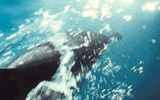Black Sea
The unique ecosystem of the North-Western Shelf of the Black Sea is burdened by excessive loads of nutrients and hazardous substances from the coastal countries and the rivers that enter it – the most important of which is the Danube, followed by the Dnjestr and the Dnjepr.
Did you know?
The Black Sea is almost completely cut off from the world's other seas and ocean. The deepest waters of the Black Sea extend to depths of well over two kilometres.
Pollution inputs and other factors have radically changed Black Sea ecosystems beginning around 1960, and seriously threatening biodiversity and our use of the sea for fishing and recreation.
In addition to nutrient pollution, other pressures on the Black Sea ecosystems include organic pesticides, heavy metals, incidental and operational spills from oil vessels and ports, over-fishing and invasions of exotic species.
The Black Sea is the world largest water body containing hydrogen sulfide. This is because it has an inflow of salty Mediterranean sea water in the deep layers and an inflow of river water on the top - so the sea is stratified and can not even be mixed by wind. This led to oxygen depletion in layers below 80 to 150 m and to the building of hydrogen sulfide.
What is the future of the Black Sea?
Nitrogen inputs into the Black Sea have been reduced recently, but are still higher as those observed during the 1960s; current phosphate inputs appear to be roughly the same as in the 1960s.
According to information from the Black Sea Commission efforts to reduce discharges from 49 high priority pollution sources, pollution from insufficiently treated waste water and airborne emissions in all the Black Sea coastal states are beginning to bear fruit, since fewer and less intense algal blooms are now being recorded in the sea, while total fish catches have increased.
Pollution from municipalities and industry is clearly declining due to the following factors:
- economic recession in the lower Danubian and former Soviet countries
- successful measures taken to reduce nutrient discharges in the upper Danube countries, including dramatic reductions in the use of fertilizers and considerable improvements in the treatment of waste water
- the implementation of a ban on polyphosphate detergents in some countries
What the ICPDR is doing
The ICPDR has joined forces with the Black Sea Commission to remedy the environmental degradation of the Black Sea through the Danube by establishing a Joint Technical Working Group. This body is currently drafting guidelines for achieving good environmental status in the coastal waters of the Black Sea, in line with EU legislation. Co-operation between the two commissions started in 1997 on a preliminary basis, and was reinforced by a Memorandum of Understanding signed at a ministerial meeting in Brussels in November 2001.
The ICPDR is also a member of the DABLAS Task Force, which was set up in November 2001 as a platform for co-operation between international financial institutions (IFIs), donors and beneficiaries with regard to the protection of water and water-related ecosystems along the Danube and in the Black Sea.
The task force includes representatives from the countries in the region, the ICPDR, the Black Sea Commission, IFIs, the EC, interested EU Member States, and other bilateral donors, as well as other regional/ and international organisations.
Disclaimer
The information contained in the ICPDR website is intended to enhance public access to information about the ICPDR and the Danube River. The information is correct to the best of the knowledge of the ICPDR Secretariat. If errors are brought to our attention we will try to correct them.
The ICPDR, expert group members, nor other parties involved in preparation of information contained on this website cannot, however, be held responsible for the correctness and validity of the data and information provided, nor accept responsibility or liability for damages or losses arising directly or indirectly from the use of the information conveyed therein.
Only those documents clearly marked ICPDR documents reflect the position of the ICPDR.
Any links to other websites are provided for your convenience only. The ICPDR does not accept any responsibility for the accuracy, availability, or appropriateness to the user's purposes, of any information or services on any other website.
When using the information and material provided on this website, credit should be given to the ICPDR.

